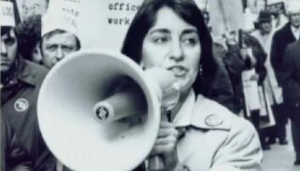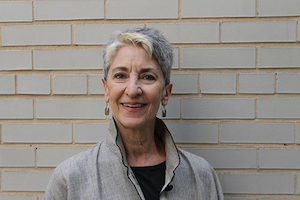
Karen Nussbaum was born on April 25th, 1950, in Chicago, Illinois, to Annette Nussbaum, a publicist, and Mike Nussbaum, an actor, director, and exterminator. Both of Nussbaum’s parents were highly active in the Chicago anti-Vietnam War movement, and in 1970, Karen moved to Boston to also become more active in the movement. Karen Nussbaum is currently married to Ira Arlook, the Chief of Advocacy Campaigns at Fenton Communications, a firm that works toward environmental justice, human rights, and more.
Nussbaum earned a Bachelor of Arts degree from The Goddard College in Plainfield, Vermont. She picked up a clerical job at Harvard University to support herself through college, where she noticed the unfair treatment of working women in America. Most notable abuses were the inadequate pay (with Nussbaum herself earning just $2/hour), blatant sexism, sexual harassment (such as catcalling and inappropriate physical contact), and little to no benefits, vacation time, or family leave.
Clerical work in the 1950s, ‘60s, and ‘70s was one of the few options for educated women who did not want to be confined to housework. The field consisted almost entirely of women, and grew rapidly, with secretaries making up 14% of the American workforce by 1971. The role of a secretary had little to no possibility for professional mobility due to societal standards for a woman’s role in the professional world, as well it exposed many women to relentless objectification and misogyny. The career path was not well-paying and left women with about $2,500 per year (about $25,000 by modern standards ), whereas most business executives made about $10,000 (about $100,000 today). Secretaries were also expected to do many tasks that were not included in their job descriptions, such as getting coffee for their bosses and doing office chores; they were often referred to as "office wives."
In 1972, Nussbaum organized a group of ten female coworkers to address the inequalities in the workforce. They held regular meetings where they could air out frustration at working jobs, under male bosses, with no opportunity for promotion. The group grew quickly, and they began printing and distributing newsletters to women on their way to work, at subway stations. They even considered turning the group into a city-wide organization.

The organization, called ‘9to5,’ consisted of about 50 members from several Harvard offices. They compiled a list of demands for the Harvard Director of Personnel, including healthcare coverage, opportunities for promotion, and respect. Ellen Cassedy, one of Nussbaum’s friends from college and fellow Harvard secretary, recalled in the documentary 9to5: The Story of a Movement that “The big revelation was that his hands were trembling. We were terrified. But he was, too.” Although the meeting did not lead to any changes among the Harvard offices, Nussbaum and Cassedy were encouraged by the fact that 9to5 was even able to organize the meeting in the first place.
After that particular meeting, 9to5 continued to grow rapidly. Ellen Cassedy went to a bootcamp at the Midwest Academy in Chicago as a 9to5 representative, where she learned the basics of organizing a successful social, economic, and racial justice movement. The organization was soon able to purchase a small office building and hire full-time members and representatives. They still distributed newsletters, but now they also surveyed women outside of office buildings, which proved to be a helpful tool in determining what working women in Boston wanted. The Boston chapter of 9to5 became so popular and successful at running meetings, that women across the country began reaching out to Nussbaum and Cassedy, and chapters began popping up across the U.S. Nussbaum discussed her experiences working at 9to5 with Jane Fonda, with whom she became acquainted from the anti-war movements, in the early 1970s. Fonda felt extremely inspired and, after discussing with many more working women across America, she decided to make the infamous 1980 film: 9 to 5.

9 to 5 stars Jane Fonda, Dolly Parton, and Lily Tomlin as three female secretaries who work for a very misogynistic boss. The secretaries abduct their boss and fantasize about the different ways they would kill him if given the chance, which was heavily influenced by Jane Fonda’s meeting with the 9to5 members where each member vividly described their own fantasies of killing their sexist bosses.
In 1981, 9to5 created a branch of the Service Employees International Union (SEIU) called SEIU Division 925 after a long and grueling fight, during which the vote to become a union was defeated two years prior. Nussbaum served as the director of SEIU District 925 from 1981-1993, and was appointed by President Bill Clinton to be the director of the U.S. Department of Labor Women's Bureau in 1993. In 2003, she started Working America at the American Federation of Labor and Congress of Industrial Organizations (AFL-CIO), which now has over 3.5 million members.
9to5 remains one of the most influential organizations for working women's rights. They successfully fought for the 1978 Pregnancy Discrimination Act, the Civil Rights Act of 1991, and many more national policies that prohibit workplace discrimination and harassment. 9to5 has changed the way that women are able to work in the United States and has given generations of women opportunities for employment, including promotional tracks, family leaves, and work environments free of discrimination and harassment.
Why Did I Choose to Research Karen Nussbaum?
I chose to research Karen Nussbaum after watching the documentary 9to5: The Story of a Movement. At the beginning of the movie, organizers and directors of chapters from across the United States were asked if anyone ever discusses 9to5 with them. Every single one of them said that no one had ever asked them about it or recognized them from the movement. I think that given the popularity of both the movie and song of the same name: 9 to 5 by Dolly Parton,, the real women whose activism inspired those stories deserve just as much popularity and credit for the changes they have initiated.
Works Cited
Nussbaum, K. (2018). Karen Nussbaum. Karen Nussbaum. https://www.karennussbaum.com/.
Inside 9to5, the movement for women’s workplace rights. (2021, February 11). Marketplace. https://www.marketplace.org/2021/02/11/inside-9to5-the-movement-for-womens-workplace-rights/.
Women’s Media Center. (2017). Womensmediacenter.com. https://womensmediacenter.com/profile/karen-nussbaum.
Nussbaum, Karen (1950—) | Encyclopedia.com. (2022). Encyclopedia.com. https://www.encyclopedia.com/women/encyclopedias-almanacs-transcripts-and-maps/nussbaum-karen-1950.
Karen Nussbaum | Wikiwand. (2022). Wikiwand. https://www.wikiwand.com/en/Karen_Nussbaum.
Leon, M. (2020, November 19). The Incredible True Story Behind Dolly Parton’s “9 to 5.” The Daily Beast; The Daily Beast. https://www.thedailybeast.com/when-fed-up-women-joined-forces-to-beat-back-the-patriarchy.
Arlook, I. (2015). Ira Arlook. The Zero Campaign. https://www.zeroemissionsnow.net/team/ira-arlook/.
Clerical Workers in the 1950s and 1960s: The Use of Oral Evidence on JSTOR. (2022). Jstor.org. https://www.jstor.org/stable/40179395.
inspiringquotes.us. (2022). Top 2 quotes of KAREN NUSSBAUM famous quotes and sayings | inspringquotes.us. Inspiring Quotes. https://www.inspiringquotes.us/author/4792-karen-nussbaum.
9to5. (2022). 9to5. https://9to5.org/.
This article was published on 1/24/23